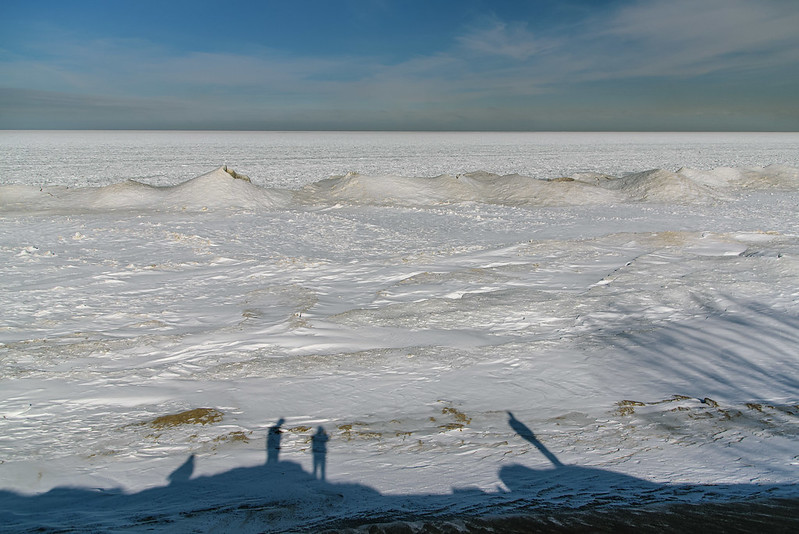
As I spent time on the beaches of Lake Michigan during the hard winter months, I began comparing the lakefront to the arctic, and at times, it looks as if you're standing on a high mountain overlooking a mountain range. I've also noticed the cone-shaped mounds look a lot like volcanoes, and after watching them over time, I've realized they are formed by very similar physics. While they're not formed by seismic activity and heat, the physics of liquid and chunks of debris being pushed upward with a lot of force, then landing around the opening from which they came, is exactly like a volcano. The waves provide the material and the force, gravity and the cold temperatures does the rest.
If it's windy when the weather turns cold, the shelf ice mounds up along the shore - often forming these conical formations. If it's relatively calm when the ice forms, the shelf ice is rather flat. If we look at the photos from this year, the beginning of the freeze up was relatively calm because the ice near the shore is flat; then some windy days occurred creating some 15 foot tall mounds a bit further away from shore.
If it's windy when the weather turns cold, the shelf ice mounds up along the shore - often forming these conical formations. If it's relatively calm when the ice forms, the shelf ice is rather flat. If we look at the photos from this year, the beginning of the freeze up was relatively calm because the ice near the shore is flat; then some windy days occurred creating some 15 foot tall mounds a bit further away from shore.
When the ice forms flat near the shore, it's a bit more hazardous for visitors who are unfamiliar with the beach and the lake. I met some first time visitors to the Indiana Dunes on Central Beach, and they casually asked if I knew where the water began. They pointed to the tall mounds thinking the water line began there. I informed them that the water line was about 20 feet from where they were standing. They were shocked, and most likely would have walked out over the flat shelf ice to the mounds thinking all the way that they were safely on the beach.
In the photo above, we are standing on the mound of sand at the entrance of Central Beach. The first line of sand colored snow is the water line - it's in the shadow of the dunes at the bottom of the photo. The relatively flat ice looks as if it's just sand, but in reality, it's shelf ice over the water. I approximate the depth of the water midway between the shore and the tall mounds of ice at 10 feet - maybe more. Those mounds are a couple hundred feet off shore, and look so inviting to run onto. There are no signs on the beach warning of the danger, only a couple of small signs in the parking area mentioning the possibility of falling through the ice. The problem is, if visitors don't know where the ice begins, they could inadvertently walk out onto it thinking they are on solid ground.
I've referred to the view of Lake Michigan in winter as the "Indiana Arctic" and the image below sure looks like it could have been taken somewhere in the arctic. These ice mounds will only be around for a couple more weeks, and suddenly, they'll be gone. It's worth a trip to the dunes now before you miss these incredible formations.




No comments:
Post a Comment